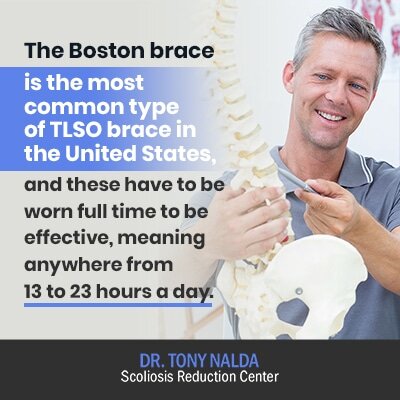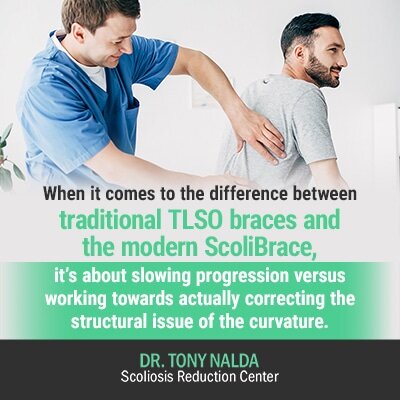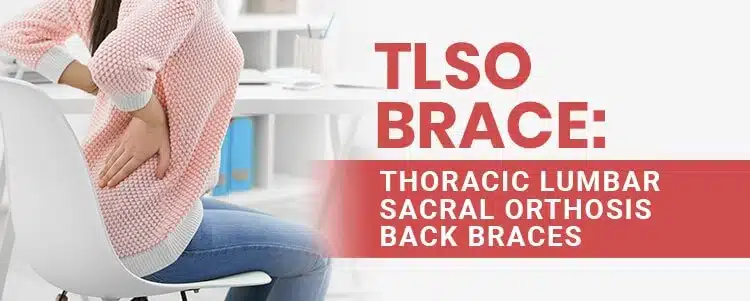Bracing is a component of treatment for scoliosis, and TLSO braces are the main type of braces used. TLSO is an acronym that stands for thoracolumbosacral orthosis, and TLSO braces are used to treat a scoliosis curve located in the mid to lower back. Bracing has a place in effective scoliosis treatment plans, but something to be aware of is the difference between traditional bracing and newer corrective bracing options such as the ScoliBrace. The former works to slow down progression; the latter actually helps correct the structural issue of the scoliosis.
As such a widespread and complex condition, scoliosis has a number of treatment options available. Before commiting to one, I highly recommend exploring all options available and making sure you understand the differences between them. When it comes to bracing, there is a big difference between what a traditional TLSO brace does to treat scoliosis and what a modern Scolibrace can do. Let’s first take a look at what TLSO braces are, how they work, and what their treatment goal is.
4 Key Insights on Scoliosis Bracing
- TLSO vs. ScoliBrace: Traditional TLSO braces, like the Boston brace, are designed to slow scoliosis progression by applying pressure to prevent curve worsening. In contrast, the modern ScoliBrace aims to correct the structural curvature of the spine through a customized, corrective approach.
- Customization and Comfort: The ScoliBrace stands out due to its customization through advanced 3D imaging, ensuring a better fit, increased comfort, and potentially higher compliance, especially important for adolescent patients.
- Treatment Goals: While TLSO braces focus on halting curve progression, the ScoliBrace, integrated into a comprehensive treatment plan, seeks to achieve actual curvature reduction, offering a more ambitious and functional treatment outcome.
- Conservative Treatment Approach: The conservative treatment approach at the Scoliosis Reduction Center® emphasizes a combination of therapies, including corrective bracing, chiropractic care, and exercises, aimed at structurally correcting scoliosis, presenting a viable alternative to invasive surgical interventions.
How Does a TLSO Back Brace Work?
The theory behind traditional bracing, such as the TLSO brace, is that pressure placed on a growing spine will slow down growth in that area.
This is the goal of traditional bracing: to slow down or stop the curvature from progressing. With a TLSO brace, there are pads that apply pressure to the spine’s unhealthy curves in the hope that the pressure will stop the curves from getting worse, which is what they naturally do when left untreated, or if treatment is ineffective.
Bracing is a facet of treatment that can help patients avoid the need for spinal-fusion surgery. Most often, for those choosing to follow the traditional treatment path, surgery is recommended when a curvature exceeds 40 degrees.
If a TLSO brace is successful at slowing down progression, that surgical threshold of 40+ degrees is not reached, or at least is not reached until further down the road.
Who is Bracing Recommended For?
Bracing is recommended for children and adolescents because entering into significant stages of growth and development, they are facing a high risk of progression. This is because growth is the number-one trigger for curvature progression. Children braces, for example, helps correct the scoliotic curve and reduce progression.
Slowing down progression via a brace isn’t commonly recommended for adults because bracing is effective on growing spines, not those that have reached skeletal maturity. When braces are recommended for adults, they are mainly used to stabilize a patient’s scoliosis and reduce pain and discomfort.

TLSO braces are mainly recommended for adolescents between the ages of 12 and 15 whose Cobb angle measurements are between 20 and 40 degrees. In these types of cases, they might need to wear the braces for as long as five years.
The Boston brace is the most common type of TLSO brace used in the United States, and these have to be worn full time to be effective, meaning anywhere from 13 to 23 hours a day.
While braces can be worn under baggy clothes, let’s think for a minute about compliance. In the majority of cases, we’re talking about teenagers: an age group not exactly known for transparency and compliance.
We’re talking about an age group that wants to fit in, blend with their peers, and wearing a mobility-restricting and uncomfortable brace full time doesn’t exactly fit that bill. If a prescribed TLSO brace isn’t worn full time as it’s supposed to be, its efficacy drops substantially.
In addition, there’s no guarantee that progression will be stopped or slowed permanently. Once that teenager reaches adulthood and skeletal maturity, there is the chance that although their progression was slowed for a time, their curvature could continue getting worse, despite going through wearing a brace for all that time.
Fortunately, there are more scoliosis treatment options available, such as the customized corrective ScoliBrace.
Why ScoliBrace Works Better
The ScoliBrace represents the latest in the evolution of bracing as a scoliosis-treatment option. The ScoliBrace works differently because it has a different treatment goal in mind. While traditional TLSO braces aim to slow down or stop progression, it does nothing to address the underlying cause of the issue: the structural deformity.
What a ScoliBrace aims to do is help the spine correct itself by pushing it into a corrective position. When paired with other facets of scoliosis-specific treatment such as chiropractic, therapy, and rehabilitation, corrective bracing can actually help correct a curvature by reducing it during wearing time, rather than just holding it in place.
The big difference, in addition to treatment goal, between traditional bracing and corrective bracing, is that corrective braces like the ScoliBrace are fully customized to suit the patient’s body and condition.
Using BraceScan, an innovative method of measurement and assessment through 3D imaging software, each brace is manufactured specifically to suit the patient’s body, curvature, and the flexibility level of their spine.
Traditional TLSO braces are not customized in this manner, making an already uncomfortable apparatus that much less appealing as it’s not specifically designed to suit the wearer.
The Conservative Treatment Approach
An alternative scoliosis-treatment approach has been gaining in popularity and respect, and that is what we offer our patients here at the Scoliosis Reduction Center®: the conservative treatment approach.
What my years of scoliosis-specific training and experience has taught me is that as we attribute the development of scoliosis to a myriad of variables that differ from patient to patient, its treatment has to be customized to address the patient’s individual condition characteristics.
Here at the Center, our patients have access to multiple treatment disciplines that we customize to suit the patient’s overall health and fitness level, their lifestyle, and their condition.
We use the ScoliBrace because we don’t want to just slow down progression; we want to actually reduce the curvature by natural means so the spine can stabilize and support itself in a corrective position. We don’t want to merely hold it in place, we want to manipulate the spine to the point that it can correct itself and sustain that level of correction throughout treatment and beyond.
The main disciplines we use to treat scoliosis are corrective bracing, therapy, rehabilitation, and chiropractic. Nothing we do is general; it’s all scoliosis-specific. Together, they complement each other to impact scoliosis by making a structural change.
Throughout treatment, we monitor our patients for progression patterns. When a patient grows, we observe how their spine is responding through X-rays, and if a certain discipline needs to be apportioned differently as the condition changes, we tweak the plan accordingly.

Treatment can be intense, but compared with the alternative option of being funneled towards spinal-fusion surgery, we have far more to offer our patients in terms of quality of life and risk factors.
Our treatment approach carries few, if any, risk factors because it’s a more natural approach, whereas the traditional spinal-fusion approach carries some heavy side effects and risks. There is also the fact that there is no long-term data that tells us what life post spinal fusion looks like 40, 50, and 60 years down the road.
When it comes to the difference between traditional TLSO braces and the modern ScoliBrace, it’s about slowing progression versus working towards actually correcting the structural issue of the curvature.
Conclusion
Bracing is one of the most common forms of treatment for scoliosis, especially with the condition’s most common form: adolescent idiopathic scoliosis. It’s often prescribed for curvatures with a Cobb angle measurement of 20, 30 degrees.
The Boston brace is the most common TLSO brace used in the States, and these traditional braces are not corrective; their treatment goal is to stop the curvature from getting worse by holding it in place. While controlling progression is an important aspect of treating scoliosis, if the structural issue of the curvature isn’t dealt with, merely holding the spine in a straighter alignment does nothing to actually correct the problem.
Enter the ScoliBrace: this customized super-corrective brace represents the culmination of what we’ve learned about bracing and scoliosis over the years. We know that scoliosis necessitates a customized treatment approach, and that extends into bracing protocol.
Here at the Scoliosis Reduction Center®, we rely on our state-of-the-art scanning technology to design a soft ScoliBrace specific to the patient’s body and curvature type, making it as comfortable and effective as possible.
The ScoliBrace doesn’t merely hold the spine in a straighter alignment; it works in conjunction with our other treatment disciplines to actually correct the abnormal curvature at a structural level.





